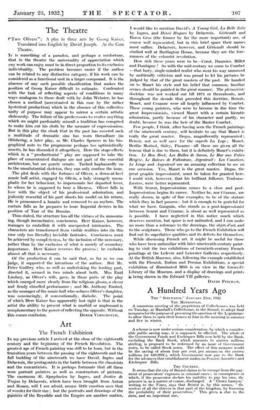Art
The French Exhibition
IN my previous article I arrived at the close of the eighteenth century and the beginning of the French Revolution. The greatest age of French painting was still to be born, but in the transition years between the passing of the eighteenth and the full budding of the nineteenth we have David, Ingres and Deliieroix, the protagonists in the battle between the classicists and the romanticists. It is perhaps fortunate that all these Were portrait painters as well as constructors of pictures. The enormous St. Symploorien by Ingres, and Justice de Trojan by Delacroix, which have been brought from Autun and .Rouen, will I am afraid, arouse little emotion save that of wonder for their size ; but the pOrtraits and drawings of the painters Of the Republic and the Empire are another matter. I would like to mention David's A Young Girl, La Belle Zak by Ingres, and Henri Hugues by Delaeroix. Gericault and Baron Gros (the former by far the more important) are, of course well represented, but in this brief space their names must suffice. Delacroix, however, and Gericault should be studied well at Burlington House, because they are the fore- runners of the colourist revolution.
How rich these years were to be—Corot, Daumder, Millet and Daubigny ! So with the mid-century we come to Courbet —that lusty, single-minded realist who went his way unmoved by unfriendly criticism and was proud to let his pictures be judged by that of the great masters of the past. He handed on to Monet his style and his belief that common, familiar scenes should be painted in the great manner. The pleinakiste doctrine was not worked out till 1871 or thereabouts, and throughout the decade that preceded this doctrine, Renoir, Monet, and Cezanne were all largely influenced by Courbet. These' young painters, who were to become in due time the great Impressionists, viewed Monet with a certain hieratic admiration, partly because of his character and partly, no doubt, because he was the heir of the Master Courbet.
Few people, I think, after having seen the French paintings of the nineteenth century, will hesitate to say that Mallet is really the great master. Degas, magnificently represented ; Renoir, not so well save for the superb La Loge ; Monet. Berthe Morisot, Sisley, Pissarro—all these are given all the honour that is due to them, but it is definitely Manet's exhibi- tion. Le Bon Bork, Les Buttes de Sawn, Le Bar aux Folks Berg?re, Le Bakal de Folkestone, Argenteuil : Les Canoliers. Le Linge and Argenteuil are an amazing collection to see on one occasion. Yes, Monet is the great master. Degas, the great graphic impressionist, must be taken for granted here. I could wish, however, that his brilliant follower, Toulouse- Lautrec, were better represented.
With Seurat, Impressionism comes to a close and post- Impressionism begins its career. Neither he, nor Uzanne, arc really shown, in spite of fine examples, to be of the stature which they in fact possess ; but it is enough to be grateful for what we have. Gauguin, who stands as a post-impressionist between Seurat and Cezanne, is about as well represented as is possible. I have neglected in this notice much which deserves mention, but space is not unlimited, and I can make no more than a reference to the drawings, the objets d'art, and to the sculptures. Those who go to the French Exhibition will find out its superlative qualities and its defects for themselves.
While discussing French art, it might be useful for those who have been unfamiliar with later nineteenth-century paint- ing to visit the two exhibitions of twentieth-century French paintings at the Lefevre and Leicester Galleries respectively. At the British Museum, also, following the example established with the Flemisli, Italian and Persian Exhibitions, a special exhibition of illuminated MSS is on view in the Grenville Library of the Museum, and a display of drawings and prints is being shown in the Edward VII galleries.
DAVID FINCIIAM.




































 Previous page
Previous page